INSTRUMEN TES ISLAM KIMIA (ITIK) UNTUK MENDETEKSI PEMAHAMAN LEVEL MIKROSKOPIS MATERI AIR
DOI:
https://doi.org/10.26740/jcer.v1n1.p1-11Keywords:
Instruments test, a microscopic representation, waterAbstract
The study aims to develop instrument to measurethe level of understanding of students and microscopic level material phase changes of water. The method used is R&D (Research and Development) Borg and Gall, which have procedure were are following step (1) Need assessment/ Plan (2) Design product/ Organization (3) Created product/ implementation. Implementation with one shot design study with samples used a number of 71 students of 10th grade MA Wahid Hasyim and senior high school MBS Yogyakarta. Indicators in the study is the movement and vibration of water particles, the distance between water particles, particle kinetic energy of water, relative atomic mass of water and hydrogen bonding. The results showed an understanding of chemica lmaterial microscopic level is low and spitual attitude as a nurturant effect is high categories.References
[1] Arikunto. (1999). Dasar-dasar Evaluasi Pendidikan (Edisi Revisi). Bandung: Bumi Aksara
[2] Berg, Euwe van den. (1991). Miskonsepsi Fisika dan Remidiasi.Salatiga: UKSW
[3] Brady, J.E. (1999). Kimia Universitas (Asas dan Unsur). Diterjemahkan oleh Sukmariah. Jakarta: Binarupa Aksara.
[4] Driver, R., Squires,A., Rushworth, P., & Wood-Robinson, V. (1994). Making Sense of Secondary Science, Research Into Childrens Ideas.Driver,R.,Squires. New York: Routledge.
[5] Gall, J., Borg. W., & Gall, M. (2003). Educational research: An introduction (7th ed.). Boston: Pearson Education
[6] Horton, C., et al. (2004). Student Altenative Conceptions in Chemistry (Originally : Student Misconceptions and Preconceptions in Chemistry). Modeling Instruction in High School Chemistry Action Research Teams at Arizona State University, diunduh pada tanggal 28 Desember 2011, dari http://www.daisly.net/hellevator/misconceptions/misconceptions.pdf
[7] Maria Evagorou, Sibel Erduran, Terhi Mantyla. (2015). The Role of Visual representations in scientific practices: from conceptual understanding and knowledge generation to seeing how science work. International Journal od STEM Education 2:11. Springer.
[8] Musfata Tuysuz., B, Ekiz., O, Bektas., E,Uzunteryaki., A,Tarkin., E, S, Kutucu., (2011). Pre-service Teachers understanding of phase changes and dissolution at macroscopic, symbolic, microscopic level. Procedia: Social and Behavioral Science 15 page 452-455. Publisher Elsevier.
[9] Noor Dayana Abd Halim., M.Bilal Ali., N, Yahaya, M,N, Haruzuan M,Said. (2013). Mental Model in Learning Chemical Bonding: A. Preliminary Study. Procedia: Sosial and Behavioral Science 97 page 224-228.
[10] Paul Suparno. (2005). Miskonsepsi dan Perubahan Konsep Pendidikan Fisika. Gramedia: Jakarta
[11] Pesman, Haki. (2005). Development of a three-tier test to asses ninth grade Student misconceptions about simple electric circuits. Tesis Master, Middle East Technical University, Turkey
[12] Putu Indrayani. (2013). Analisis pemahaman makroskopis, mikroskopis, dan simbolik titrasi asam basa siswa kelas XII IPA SMA serta upaya perbaikannya dengan pendekatan mikroskopis. Jurnal Pendidikan Sains Vol 1 No.2 Hal 109-120.
[13] Sarikaya, Mustafa. (2007). Prospective Teachers Misconceptions About The Atomic Structure in The Context of Electrification by Friction and an Activity in Order to Remedy Them. International Education Journal, 2007, 8(1), 40-63
[14] Sukarjo & Sari, Lis. P. (2008). Penilaian Hasil Belajar Kimia. Yogyakarta : UNY
[15] Suparno, Paul. (2005). Miskonsepsi & Perubahan Konsep Pendidikan Fisika. Jakarta: Grasindo
Downloads
Published
Issue
Section
 Abstract views: 779
,
Abstract views: 779
, PDF Downloads: 1074
PDF Downloads: 1074



